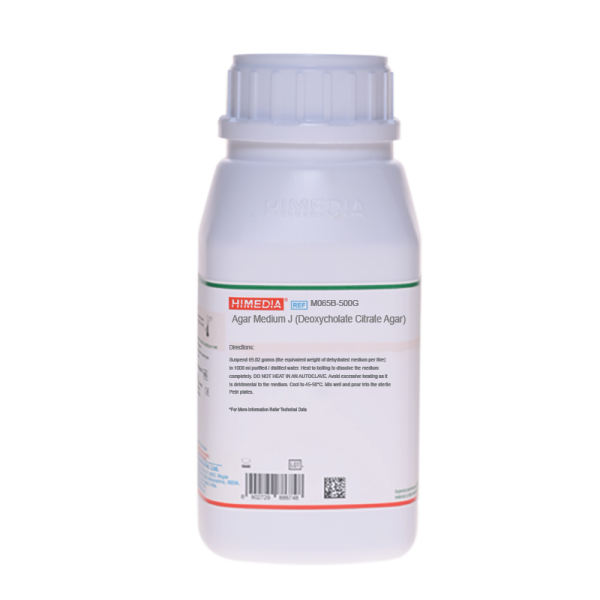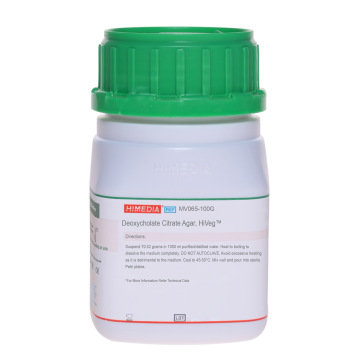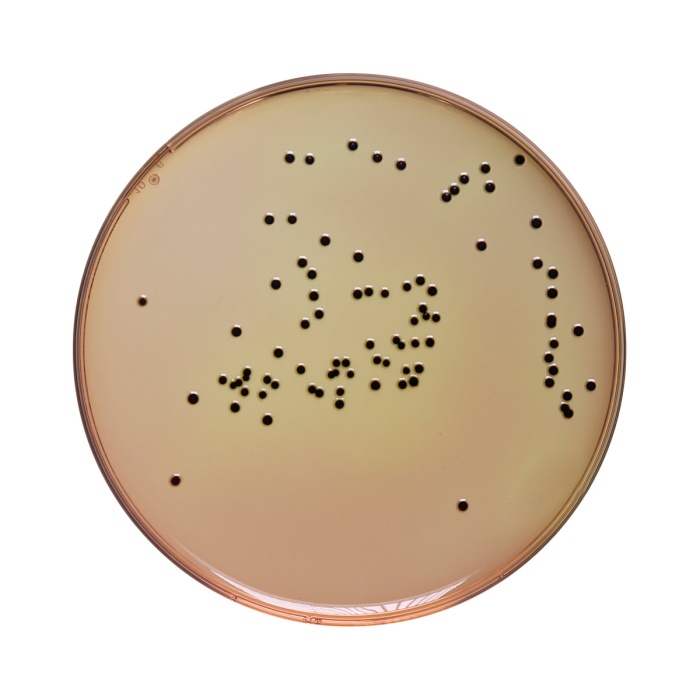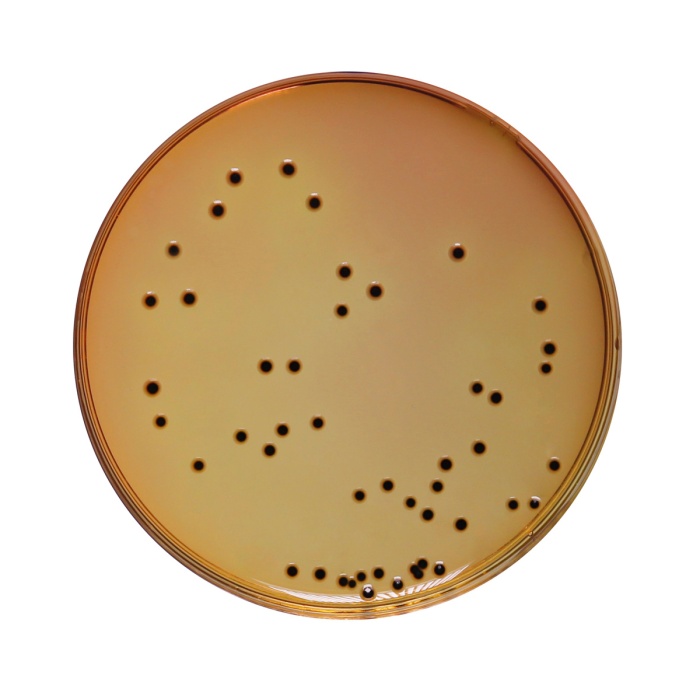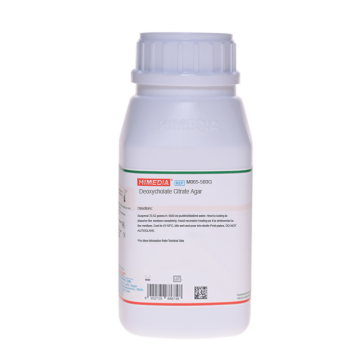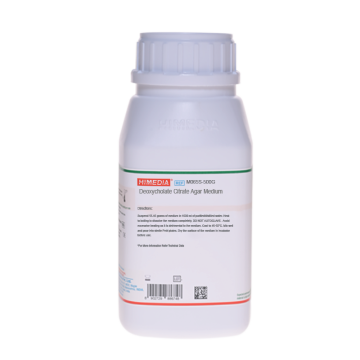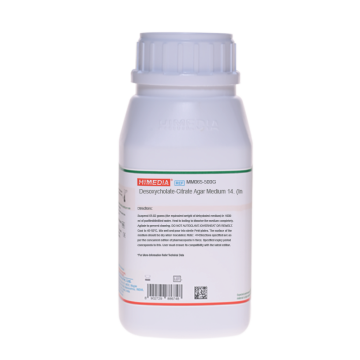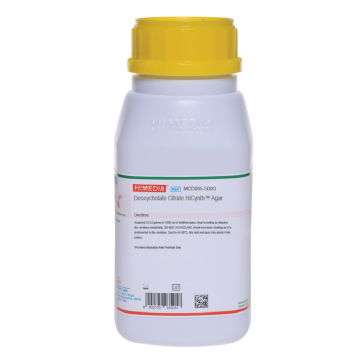 Your enquiry has been submitted
Your enquiry has been submitted
Agar Medium J (Deoxycholate-Citrate Agar)
Intended Use
Recommended for selective isolation of enteric pathogens in accordance with BP.
Composition
| Ingredients | Gms/Litre |
|---|---|
| HM peptone # | 10.000 |
| HM peptone B ## | 10.000 |
| Lactose monohydrate | 10.000 |
| Sodium citrate | 20.000 |
| Ferric citrate | 1.000 |
| Sodium deoxycholate | 5.000 |
| Neutral red | 0.020 |
| Agar | 13.500 |
pH after heating: 7.3±0.2
**Formula adjusted, standardized to suit performance parameters
# Meat peptone
## Beef extract
Directions
Suspend 69.02 grams of dehydrated powder in 1000 ml of purified / distilled water. Heat gently to boiling to dissolve the medium completely. DO NOT AUTOCLAVE. Avoid excessive heating as it is detrimental to the medium. Cool to 45-50° C. Mix well before pouring into sterile Petri plates.
Principle And Interpretation
Deoxycholate Citrate Agar Medium is prepared as per the modified formula of Leifson (5) and is also recommended as per British Pharmacopoeia and is also designated as Agar medium J (1). This medium is used for the isolation and maximum recovery of intestinal pathogens belonging to Salmonella and Shigella groups from foods and pharmaceutical products (6).
However, it is recommended to use less inhibitory medium when Shigella have to be isolated (2). Salmonella major causative agent of enteric disease especially food borne toxic infection and typhoid was first observed by Eberth in 1880. This medium is routinely used to check the presence of Salmonella contamination in food and pharmaceutical products as per BP.
Sodium deoxycholate at pH 7.3 to 7.5 is inhibitory for gram-positive bacteria. Proteus and other Gram positive organisms are also inhibited due to higher concentration of both citrate and deoxycholate salts in this medium. The reduction of ferric citrate to iron sulphide by H2S gives the indicative appearance of colonies with black center. Citrate salt, in the concentration included in the formulation, are inhibitory to gram-positive bacteria and most other normal intestinal organisms. Combination of HM peptone and HM peptone B supplies nitrogen, mineral, vitamin factors required for enhanced growth. Lactose monohydrate supplies fermentable carbohydrate source in this medium. Neutral red acts as indicators, in presence of which lactose fermenters like coliform bacteria give pink colonies while lactose non-fermenters give colourless colonies.
Salmonella gives well-developed colourless colonies. Precipitation of deoxycholate by acid produced by lactose fermenters may give a zone of precipitation around the colony. This medium provides essential growth factors for growth of several auxotrophic strains of Paratyphi and Typhi. The selectivity of this medium permits the use of fairly heavy inocula without danger of overgrowth of Shigella and Salmonella by other microflora.
Type of specimen
Pharmaceutical samples
Specimen Collection and Handling
For pharmaceutical samples follow appropriate techniques for handling specimens as per established guidelines (1).
After use, contaminated materials must be sterilized by autoclaving before discarding.
Warning and Precautions
Read the label before opening the container. Wear protective gloves/protective clothing/eye protection/ face protection. Follow good microbiological lab practices while handling specimens and culture. Standard precautions as per established guidelines should be followed while handling specimens. Safety guidelines may be referred in individual safety data sheets.
Limitations
- Due to nutritional variations certain strains may show poor growth.
Performance and Evaluation
Performance of the medium is expected when used as per the direction on the label within the expiry period when stored at recommended temperature.
Quality Control
Appearance Light yellow to pinkish beige homogeneous free flowing powder
Gelling Firm, comparable with 1.35% Agar gel.
Colour and Clarity of prepared medium Reddish orange coloured clear to slightly opalescent gel forms in Petri plates.
pH 7.10-7.50
Growth Promotion Test Growth Promotion is carried out in accordance with BP.
Cultural Response Cultural response was observed after an incubation at 35-37°C for 18-72 hours. Recovery rate is considered as 100% for bacteria growth on Soyabean Casein Digest Agar.
| Organism | Inoculum (CFU) | Growth | Observed Lot Recovery value (CFU) | Colour of colony | |
|---|---|---|---|---|---|
| Test for Salmonella | |||||
| Salmonella Typhimurium ATCC 14028 (00031*) | 50-100 | luxuriant | 25-100 | >=50% | colourless colonies |
| Salmonella Abony NCTC 6017 (00029*) | 50-100 | luxuriant | 25-100 | >=50% | colourless colonies |
| Additional Microbiological testing | |||||
| Salmonella Enteritidis ATCC 13076 (00030*) | 50-100 | luxuriant | 25-50 | >=50% | colourless colonies |
| Enterococcus faecalis ATCC 29212 (00087*) | >=104 | inhibited | 0 | 0% | |
| Escherichia coli ATCC 8739 (00012*) | 50-100 | Poor | 15-30 | 20-30% | pink with bile precipitate |
Key: *Corresponding WDCM numbers.
Storage and Shelf Life
Store between 10-30°C in a tightly closed container and the prepared medium at 20-30°C. Use before expiry date on the label. On opening, product should be properly stored dry, after tightly capping the bottle in order to prevent lump formation due to the hygroscopic nature of the product. Improper storage of the product may lead to lump formation. Store in dry ventilated area protected from extremes of temperature and sources of ignition. Seal the container tightly after use. Product performance is best if used within stated expiry period.
Disposal
User must ensure safe disposal by autoclaving and/or incineration of used or unusable preparations of this product. Follow established laboratory procedures in disposing of infectious materials and material that comes into contact with sample must be decontaminated and disposed of in accordance with current laboratory techniques (3,4).
Reference
- British Pharmacopoeia, 2009, The Stationery office British Pharmacopoeia.
- Frieker C.R., 1987, J. Appl. Bact., 63:99.
- Isenberg, H.D. Clinical Microbiology Procedures Handbook 2nd Edition.
- Jorgensen, J.H., Pfaller, M.A., Carroll, K.C., Funke, G., Landry, M.L., Richter, S.S and Warnock., D.W. (2015) Manual of Clinical Microbiology, 11th Edition. Vol. 1.
- Leifson, 1935, J. Path. Bact., 40:581.
- Speck M. (Eds.), 1984, Compendium of Methods for the Microbiological Examination of Foods, 2nd ed., APHA, Washington, D.C.
| Product Name | Agar Medium J (Deoxycholate-Citrate Agar) |
|---|---|
| SKU | M065B |
| Product Type | Regular |
| Physical Form | Powder |
| Origin | Animal |
| Packaging type | HDPE |
| References | 1. Leifson, 1935, J. Path. Bact., 40:581. 2.Speck M. (Ed.), 1984, Compendium of Methods for the Microbiological Examination of Foods, 2nd ed., APHA,Washington, D.C. 3.Frieker C.R., 1987, J. Appl. Bact., 63:99. 4.Isenberg, H.D. Clinical Microbiology Procedures Handbook. 2nd Edition. 5.Jorgensen,J.H., Pfaller , M.A., Carroll, K.C., Funke, G., Landry, M.L., Richter, S.S and Warnock., D.W. (2015)Manual of Clinical Microbiology, 11th Edition. Vol. 1. |
| Customized Product Available | No |



